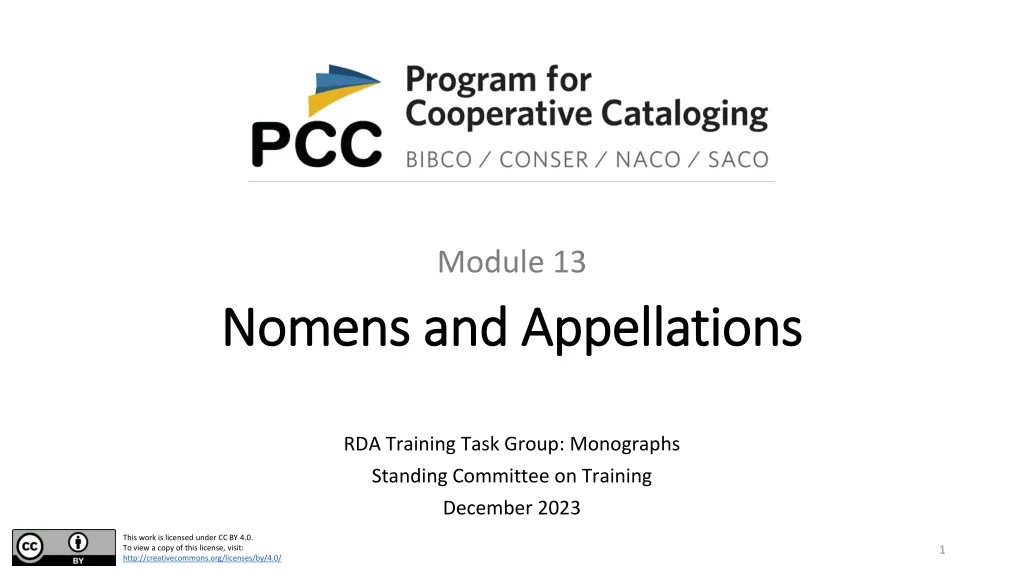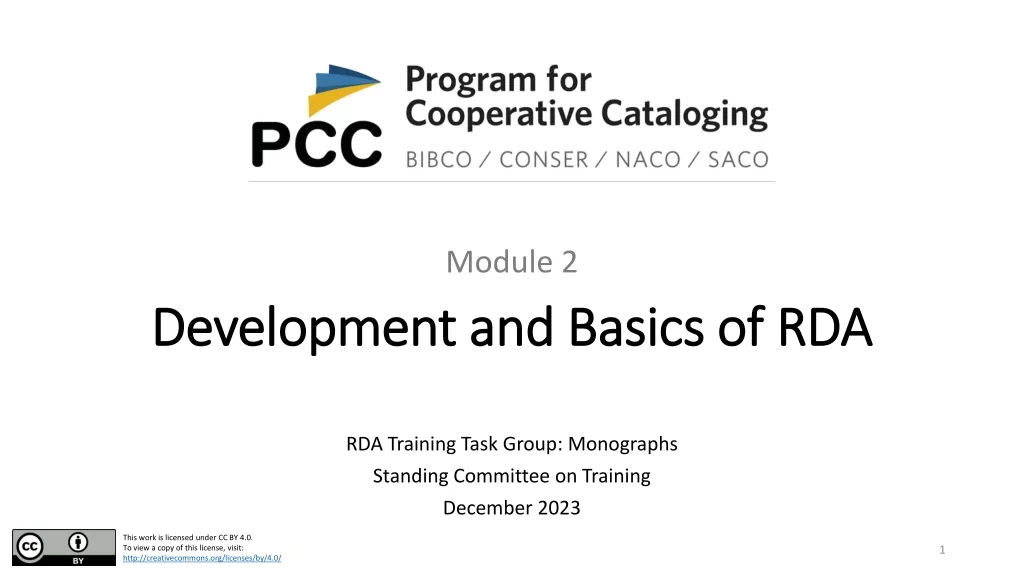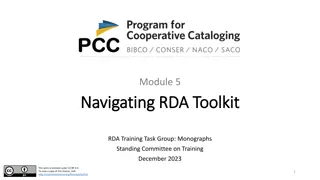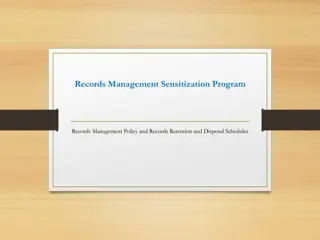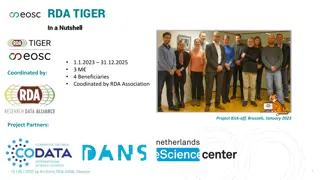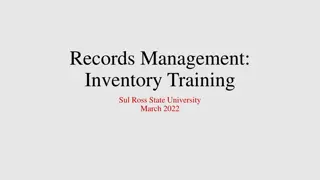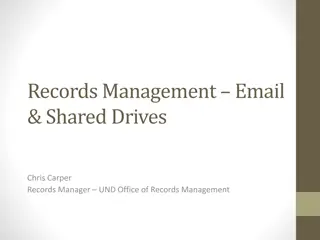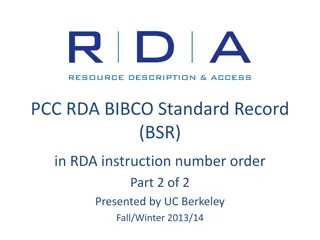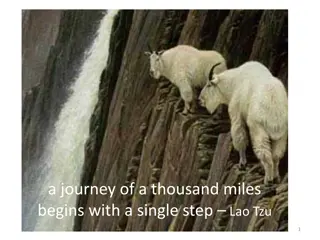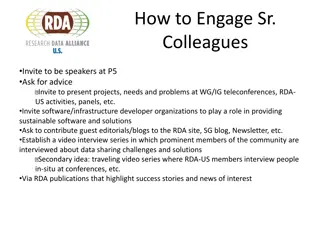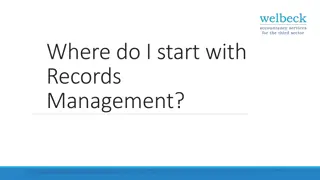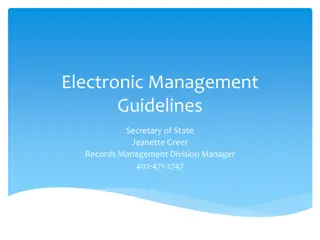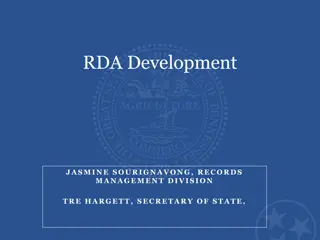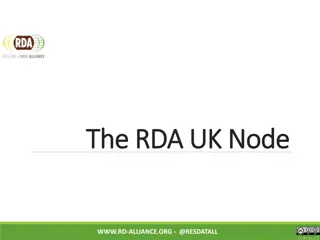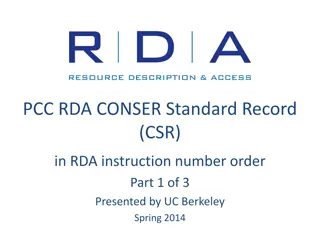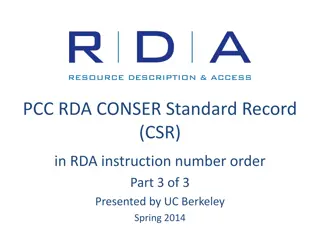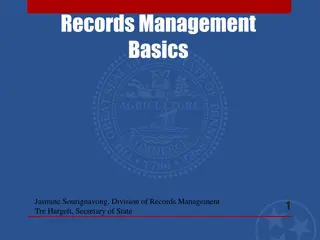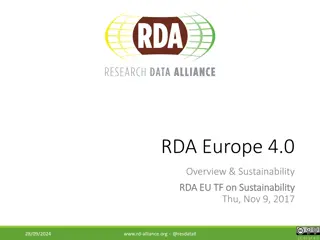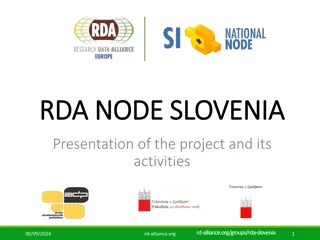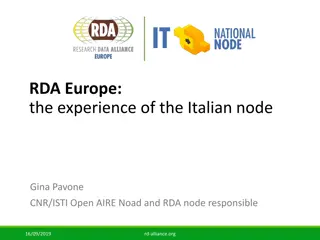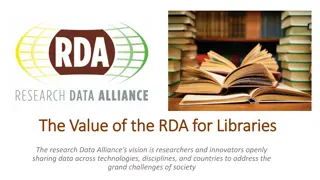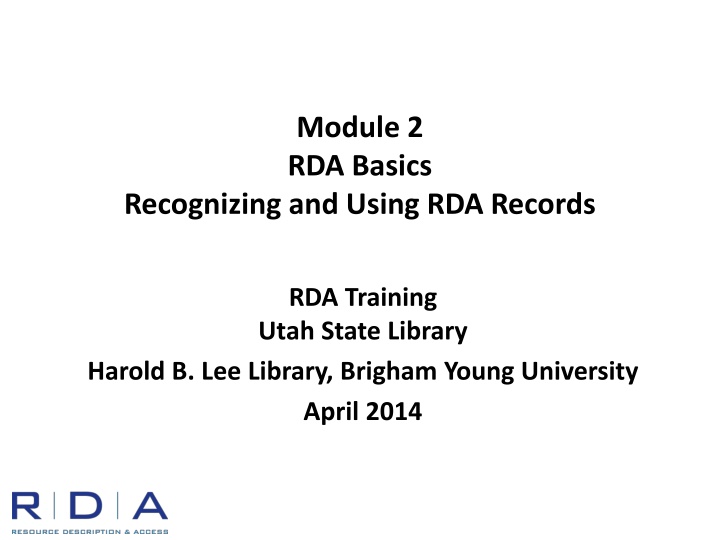
RDA Records Creation and Policies Overview
Gain insights into creating and managing RDA records, including policies from OCLC and PCC. Learn about the transition from AACR2 to RDA, accessing authority files, and major revisions to the NACO Authority File.
Download Presentation

Please find below an Image/Link to download the presentation.
The content on the website is provided AS IS for your information and personal use only. It may not be sold, licensed, or shared on other websites without obtaining consent from the author. If you encounter any issues during the download, it is possible that the publisher has removed the file from their server.
You are allowed to download the files provided on this website for personal or commercial use, subject to the condition that they are used lawfully. All files are the property of their respective owners.
The content on the website is provided AS IS for your information and personal use only. It may not be sold, licensed, or shared on other websites without obtaining consent from the author.
E N D
Presentation Transcript
Module 2 RDA Basics Recognizing and Using RDA Records RDA Training Utah State Library Harold B. Lee Library, Brigham Young University April 2014
Please log in to RDA http://access.rdatoolkit.org/login ID: aprilrda Password: training Please feel free to sign up later for a month s free access so you can practice (see handout) Module 2. Recognizing and Using RDA Records 2
RDA Record Creation (OCLC) Anyone can create RDA bibliographic records in OCLC, following OCLC s policies You can also revise AACR2 or other pre-RDA records to include RDA elements. Access points should conform to RDA. If the revised record as a whole conforms to RDA, you may recode it to RDA Module 2. Recognizing and Using RDA Records 3
OCLC RDA Policy (bibliographic records) http://www.oclc.org/rda/new-policy.en.html Original cataloging may be contributed in RDA Non-RDA master records may be upgraded to RDA Do not convert RDA records back to AACR2 Some RDA elements may be added to non-RDA records without fully upgrading the record Module 2. Recognizing and Using RDA Records 4
The LC/NACO Authority File No AACR2 work has been allowed in the File since March 31, 2013. AACR2 authority records remain in the File, but will be converted to RDA as needed. The file is available at: authorities.loc.gov or in OCLC Connexion Module 2. Recognizing and Using RDA Records 5
PCC RDA Policy (authority records) Original authority records must be RDA. If any change is made to a non-RDA authority record it must be converted to RDA RDA elements may be added If the RDA authorized access point is different from AACR2, the 1XX should be changed The old heading is recorded in 4XX with $w nnea The record is then recoded to RDA Module 2. Recognizing and Using RDA Records 6
Major revisions to the NACO Authority File Phase One (early summer 2012). 667 field inserted in selected records reading: 667 $a THIS 1XX FIELD CANNOT BE USED UNDER RDA UNTIL THIS RECORD HAS BEEN REVIEWED AND/OR UPDATED Module 2. Recognizing and Using RDA Records 7
Major revisions to the NACO Authority File Phase two (completed March 2013). Programmatic changes to the NACO authority file and the OCLC bibliographic file, including: Expand the abbreviations arr. , acc. and unacc. Modify Bible headings Expand the abbreviation Dept. Modify violoncello headings Modify Koran headings Modify Selections uniform titles Modify dates of persons (e.g. b. 1850 => 1850- ) Module 2. Recognizing and Using RDA Records 8
How do I recognize an RDA record? 040 $e rda Presence of new RDA elements in the record Bibliographic records: Desc fixed field = i (vs. a for AACR2) Authority records: Rules fixed field = z (vs. c for AACR2) Module 2. Recognizing and Using RDA Records 9
Where can I find some examples? In OCLC, do a command line search dx:rda You will need to limit (e.g. by date) because there are now nearly 170,000 RDA records in OCLC, too many for the search to display without limits In the BYU Library catalog (catalog.lib.byu.edu), do a search all keyword search using rda{040} Module 2. Recognizing and Using RDA Records 10
Module 2. Recognizing and Using RDA Records 11
Module 2. Recognizing and Using RDA Records 12
Module 2. Recognizing and Using RDA Records 13
Module 2. Recognizing and Using RDA Records 14
Module 2. Recognizing and Using RDA Records 15
Module 2. Recognizing and Using RDA Records 16
Module 2. Recognizing and Using RDA Records 17
Module 2. Recognizing and Using RDA Records 18
Module 2. Recognizing and Using RDA Records 19
Module 2. Recognizing and Using RDA Records 20
Module 2. Recognizing and Using RDA Records 21
Where can I find some examples of RDA authority records? In Connexion, dx:rda in authority command line search; you can the limit search The access points on most RDA records from BYU (OCLC symbol = UBY) are authorized by RDA authority records or AACR2 authority records with RDA elements Example of a bibliographic command line search to find these: li:uby dx:rda/1960-1969 Module 2. Recognizing and Using RDA Records 22
Module 2. Recognizing and Using RDA Records 23
Module 2. Recognizing and Using RDA Records 24
Module 2. Recognizing and Using RDA Records 25
Module 2. Recognizing and Using RDA Records 26
How can we take advantage of RDA records? Module 2. Recognizing and Using RDA Records 27
New Elements : Bibliographic General Material Designation abolished, replaced by Content Type Media Type Carrier Type Module 2. Recognizing and Using RDA Records 28
Media type Categorization reflecting the general type of intermediation device required to view, play, run, etc., the content of a resource (RDA 3.2.1). Media type is not a core element. audio computer microform microscopic projected stereographic unmediated video other unspecified Module 2. Recognizing and Using RDA Records 29
Media type New MARC field 337 337 $a audio $2 rdamedia 337 $a unmediated $2 rdamedia This element may be repeated if there is more than one media type. This can be done either with separate 337 fields, or by repeating subfield $a in a single 337 field. Module 2. Recognizing and Using RDA Records 30
Carrier type Categorization reflecting the format of the storage medium and housing of a carrier in combination with the type of intermediation device required to view, play, run, etc., the content of a resource (RDA 3.3.1). Carrier type is a core element. A few examples (not a complete list) stereograph card flipchart volume videodisc other unspecified audio disc computer card microfiche microscope slide film cassette overhead transparency Module 2. Recognizing and Using RDA Records 31
Carrier type New MARC field 338 338 $a videodisc $2 rdacarrier 338 $a volume $2 rdacarrier This element may be repeated if there is more than one media type. This can be done either with separate 338 fields, or by repeating subfield $a in a single 338 field. Module 2. Recognizing and Using RDA Records 32
Content type Categorization reflecting the fundamental form of communication in which the content is expressed and the human sense through which it is intended to be perceived. (RDA 6.9.1). Content type is a core element. A few examples (not a complete list) two-dimensional moving image still image three-dimensional form other unspecified cartographic image notated music performed music spoken word still image text Module 2. Recognizing and Using RDA Records 33
Content type New MARC field 336 336 $a notated music $2 rdacontent 336 $a spoken word $2 rdacontent This element may be repeated if there is more than one media type. This can be done either with separate 336 fields, or by repeating subfield $a in a single 336 field. Module 2. Recognizing and Using RDA Records 34
GMD vs. Types in MARC AACR2 RDA 245 10 $a F nf Violinkonzerte $h [electronic resource] / $c Giuseppe Tartini. 300 $a 1 online resource 245 10 $a F nf Violinkonzerte / $c Giuseppe Tartini. 300 $a 1 online resource 336 $a performed music $2 rdacontent 337 $a computer $2 rdamedia 338 $a online resource $2 rdacarrier Module 2. Recognizing and Using RDA Records 35
GMD vs. Types in user display AACR2 catalog display Title: Crazy heart [sound recording] : original motion picture soundtrack. RDA catalog display Title: Crazy heart : original motion picture soundtrack. Medium: audio Format: audio disc Content type: performed music Alternately,the RDA types could be displayed as icons. Module 2. Recognizing and Using RDA Records 36
New Elements : Bibliographic Relationship designators 100 1 $a Card, Orson Scott, $e author. 240 10 $a First meetings. $l French 245 10 $a Ender Wiggin : $b premi res rencontres / $c Orson Scott Card ; traduit de l anglais par Florence Bury. 700 1 $a Bury, Florence, $e translator. Module 2. Recognizing and Using RDA Records 37
New Elements : Bibliographic Relationship terms 100 1 $a Card, Orson Scott, $e author. 245 10 $a Hidden empire / $c Orson Scott Card. 250 $a First mass market edition. 700 1 $i Sequel to (work): $a Card, Orson Scott. $t Empire. Module 2. Recognizing and Using RDA Records 38
Possible index display using relationship terms Catalog browse by author: Moser, Barbara, author. Moser, Barry, author. Moser, Barry, book designer. Moser, Barry, illustrator. Moser, Barry, signer. Moser, Barry, wood-engraver. Moser, Benjamin, author. 1 hit 17 hits 5 hits 64 hits 1 hit 29 hits 4 hits Module 2. Recognizing and Using RDA Records 39
Module 2. Recognizing and Using RDA Records 40
New Elements: Authority Dates (046) Content type (336) Other attributes of person or corporate body (368) Associated place (370) Address (371) Field of activity (372) Affiliation (373) Occupation (374) Gender (375) Family info (376) Language (377) Fuller form of personal name (378) Form of work (380) Medium of performance (382) Musical work number (383) Key of musical work (384) Module 2. Recognizing and Using RDA Records 41
Searching by attribute in OCLC AF Module 2. Recognizing and Using RDA Records 42
Module 2. Recognizing and Using RDA Records 43
Module 2. Recognizing and Using RDA Records 44
New Practices Very few abbreviations Publisher statements fully transcribed Elimination of rule of three More names will appear in title page transcriptions Potentially, more names will be given access points in the record Module 2. Recognizing and Using RDA Records 45
New Vocabulary AACR2 Heading Main entry Title main entry Added entry See reference Uniform title RDA Authorized access point Principal creator (no equivalent) Access point Variant access point Preferred title, also Authorized access point for a work or expression Module 2. Recognizing and Using RDA Records 46
New Vocabulary AACR2 (no equivalent) (no equivalent) RDA Element (= FRBR s FRBR terms such as expression manifestation user tasks attribute) Module 2. Recognizing and Using RDA Records 47
RDA Terminology Quiz Module 2. Recognizing and Using RDA Records 48
Module 2 RDA Basics Recognizing and Using RDA Records RDA Training Utah State Library Harold B. Lee Library, Brigham Young University April 2014 Module 2. Recognizing and Using RDA Records 49
This Presentation is available at http://net.lib.byu.edu/~catalog/people/rlm/ RDAUtah201404/index.htm For further information contact Robert L. Maxwell robert_maxwell@byu.edu Module 2. Recognizing and Using RDA Records 50

